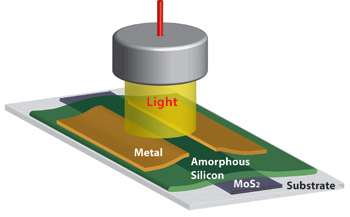Auto lubricant could rev up medical imaging

Engineers at the University of California, Berkeley, have built a device that could speed up medical imaging without breaking the bank. The key ingredient? An engine lubricant called molybdenum disulfide, or MoS2, which has been sold in auto parts shops for decades.
Many photodetectors in large-area imaging devices use amorphous silicon because it absorbs light well and is relatively inexpensive to process. But this type of silicon has defects that prevent the fast, ordered movement of electrons, leading to slower operating speeds and more exposure to radiation. Getting better performance requires more expensive, high-temperature processing, adding to the price tag of the imaging device.
Sayeef Salahuddin, UC Berkeley assistant professor of electrical engineering and computer sciences, and postdoctoral scholar Mohammad Esmaeili-Rad solved this problem by pairing a thin film of MoS2 with a sheet of amorphous silicon. Because of the molecular structure of MoS2, the photo-generated electrons it collects are able to move through quickly.
Together, the MoS2 and amorphous silicon formed a diode that resulted in a photoresponse rate that was 10 times faster than conventional amorphous silicon alone.
"Our discovery could bring transformational changes in applications from biomedical imaging to solar cells to energy-efficient transistors," said Salahuddin.
The researchers published their findings today (Aug. 2) in the open-access journal Scientific Reports.
They point out that because these materials are easy and inexpensive to handle, the cost of speeding up photodetectors would be minimal. Unlike conventional semiconductors like silicon, MoS2 consists of individual nanosheets that can be torn off like pages in a book. These sheets can be used to make thin, novel electronic devices or to improve existing ones.
Journal information: Scientific Reports
Provided by University of California - Berkeley



















